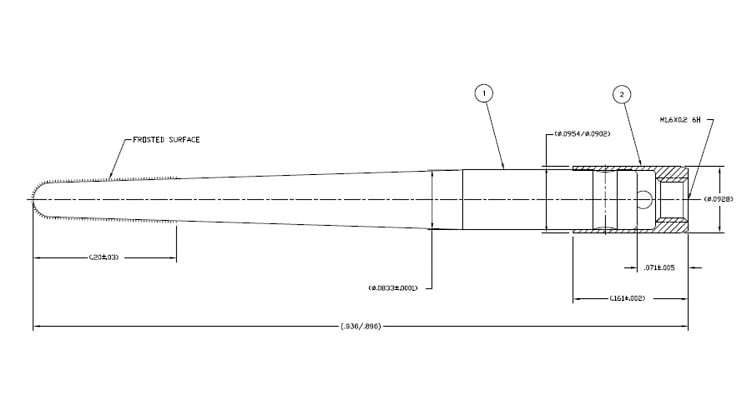
Overview
This paper explains the capability of synthetic sapphire in surgical and endoscopic applications.
Synthetic sapphire is a highly valuable material in various surgical applications due to its exceptional properties. Sapphire is a form of crystalline aluminum oxide (Al2O3) and is produced in laboratories rather than being mined from natural sources. It possesses several characteristics that make it ideal for surgical use.
Understanding Synthetic Sapphire
Biocompatibility: Synthetic sapphire is biologically inert and does not trigger adverse reactions when it comes into contact with human tissue. This property is crucial in surgical applications, as it minimizes the risk of tissue irritation or rejection.
Hardness and durability: Sapphire is one of the hardest known materials, ranking 9 on the Mohs scale of mineral hardness (diamond is the hardest at 10). This extreme hardness makes it highly resistant to scratching, wear, and corrosion, ensuring a long-lasting and reliable surgical instrument.
Transparency: Synthetic sapphire exhibits excellent optical clarity, allowing for superior visibility in surgical procedures. It is used as lenses for endoscopes, microscopes, and lasers, enabling surgeons to see and work with high precision and accuracy.
Chemical inertness: Sapphire is chemically inert and does not react with most substances, ensuring it remains unaffected by cleaning agents, sterilization methods, and bodily fluids during surgical procedures.
A comprehensive review of the various types of synthetic sapphire and properties can be found here: https://analyticalcomp.com/hard-materials-and-synthetic-sapphire/
Sapphire use in surgical applications
Sapphire is used to create high-quality scalpel blades, lancets, and other cutting tools. Its hardness allows for extremely sharp edges, leading to precise incisions and reduced tissue trauma. See figure #1 for an example of a sapphire scalpel tip design.
For laser surgery, Sapphire is utilized as a window material for medical lasers due to its excellent thermal and optical properties. It allows the laser beam to pass through with minimal energy loss and provides a clear view for the surgeon during laser procedures.
In dental applications, Synthetic sapphire is used in dentistry for creating sharp dental tools and optical components for dental imaging devices. With usage in implantable devices, Sapphire can be used in certain implantable medical devices like sensors and pacemakers due to its biocompatibility and resistance to bodily fluids.
Camera applications in surgical robotics utilize sapphire windows in the camera modules. The optical requirements for the sapphire are very high including specifications on bubbles and inclusions, surface imperfections, polish and AR coating. Some applications require metalized plating on the windows as well for fitment purposes.
The unique combination of biocompatibility, hardness, and optical clarity makes synthetic sapphire an invaluable material for enhancing the precision, safety, and efficiency of various surgical procedures.
Sapphire use in endoscopic applications
In endoscopic surgery, synthetic sapphire lenses are employed in endoscopes, which are used to visualize internal organs and perform minimally invasive procedures. The optical clarity of sapphire enhances image quality and ensures minimal distortion.
Synthetic sapphire is crucial for providing high-quality images during endoscopic procedures. Endoscopy is a medical procedure that involves inserting a flexible or rigid tube with a camera and light source (endoscope) into the body to visualize and diagnose various internal conditions. Here’s how synthetic sapphire is utilized in endoscopic applications:
Lens systems: Synthetic sapphire is used to create high-quality lenses for endoscopes. These lenses are crucial for transmitting and focusing light onto the target area inside the body, as well as capturing clear and detailed images. Sapphire’s optical clarity ensures minimal distortion and superior image resolution, enabling physicians to obtain accurate visual information during the procedure. See figure #2 for an example of an endoscope camera with sapphire lens.

Figure #2
Light guides and windows: Sapphire is employed as a material for light guides and windows in endoscopes. Light guides made from sapphire help transmit light from the light source to illuminate the internal area being examined. The optical properties of sapphire allow efficient light transmission with minimal loss, ensuring adequate illumination and visibility during the procedure. Sapphire windows protect the sensitive optical components inside the endoscope while maintaining optical transparency.
Distal tip components: The distal tip of an endoscope is the part that enters the body and captures images. Synthetic sapphire is used to create components such as windows and protective covers for the distal tip. These components provide optical clarity and protect the delicate camera and light source from bodily fluids and potential damage.
Scratch resistance: Sapphire’s exceptional hardness makes it highly resistant to scratching and wear, ensuring the endoscope’s lens and other optical components remain clear and functional over time. This is especially important in endoscopic applications, where the equipment may encounter challenging conditions during use and sterilization.
Sterilization compatibility: Synthetic sapphire is compatible with common sterilization methods, such as autoclaving and chemical sterilization, which are crucial for maintaining the endoscope’s hygiene between uses.
A major concern in endoscopic applications is impact damage caused by dropping the endoscope onto a hard surface cracking the distal window or in some instances where power tools (e.g. used in Arthroscopy) make contact with the window surface. Most manufactures now employ synthetic sapphire being a very hard material with the intention that it is more durable than conventional optical glass and less liable to suffer this type of damage.
With the integrity of the window impaired a leak will occur allowing saline etc. to enter the optic assembly staining the lenses and in some instances breaking down the cement (adhesive) between the optical surfaces. If the window seal is breached during use or general handling and then placed say in an autoclave the optic assembly will probably fail leading to a significant repair or replacement charges.
All endoscope should be checked out at each end (proximal and distal) before they are placed in any form of cleaning, sterilizing or disinfections system.
Overall, synthetic sapphire’s combination of optical clarity, scratch resistance, and sterilization compatibility makes it an excellent material for enhancing the performance and longevity of surgical and endoscopic equipment. Its use in surgical and endoscopy allows medical professionals to perform minimally invasive procedures with clear and precise visualization, leading to improved diagnostic accuracy and patient outcomes.









